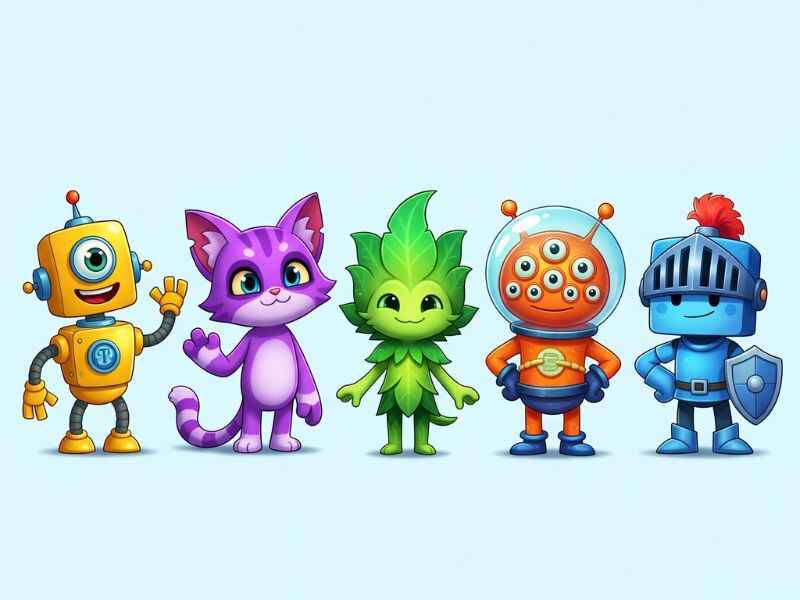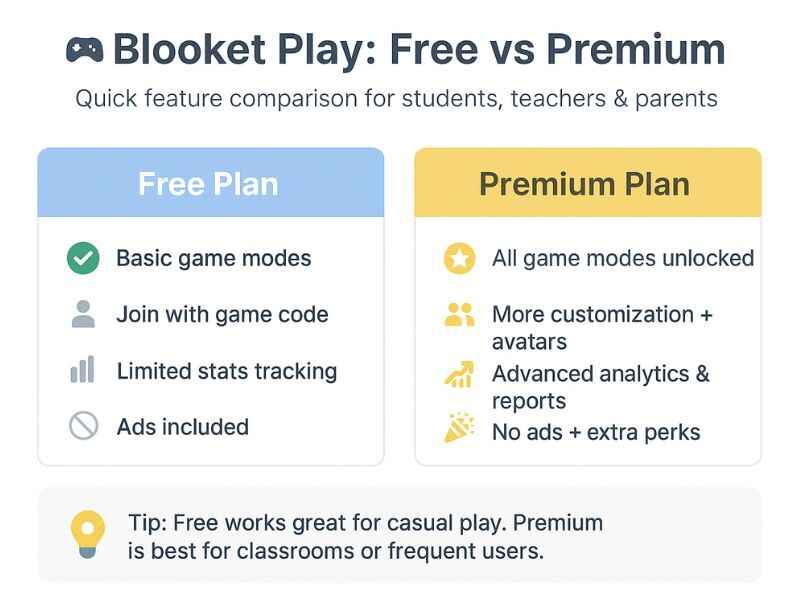Have you ever heard kids or teachers talk about blooket play? It is a website where learning feels like a game. People of all ages are curious about it. Some want to know if it is really fun. Others wonder if it is safe.
This article is for everyone — kids, parents, and teachers. We will look at the good parts and the not-so-good parts. You will learn how it works, why so many people use it, and if it is the right choice for you.
We will not only talk about the fun side. We will also share the real truth. That means the benefits, the problems, and the risks. By the end, you will know if blooket play is helpful, safe, or maybe not the best for you.
What Is Blooket Play and How Does It Work?
How Students Join a Game
Blooket play is a place where students can join a game with a simple code. A teacher or host starts the game. The student goes to the play page, types the code, and enters. It works on laptops, tablets, and even phones. No big download is needed.
Picking Names and Avatars
When you join, the first step is to pick a name. Some kids type their own names. Some use silly nicknames. After that comes the fun part — you get to choose a little character called a “Blook.” This is called avatar selection gaming. These tiny avatars make the game more fun and personal.

Playing and Answering Questions
The main idea is simple: the teacher asks questions, and students try to answer them. The answers show up inside a game world. This could look like a race, a tower, or even a battle. Every right answer moves you forward. This makes student participation online stronger because kids want to play, not just listen.
Why Teachers and Families Use It
Teachers like it because it works as classroom review tools. Instead of boring tests, the game checks if students remember the lesson. Kids feel less stress, and teachers still see who needs help.
Blooket play is not only for schools. Families use it at home, too. Parents can set up a quiz for fun learning. Friends can play for a challenge. It is simple to start and quick to join, which is why many people enjoy it.
The Rise of Game-Based Learning Platforms
Schools are changing the way they teach. In the past, lessons meant books, chalkboards, and long talks. Now, more schools use a game-based learning platform. This means kids can learn by playing games instead of only listening.
Why do schools use this? Because kids pay more attention when the lesson feels fun. In a math class, for example, solving a problem can unlock points or power-ups. In science, answering questions can move a rocket higher in space. These educational quiz games turn hard lessons into playful tasks.
Parents also notice changes. Some love digital tools because they keep kids interested. They see their children asking to “play homework” instead of avoiding it. Others worry about screen time. Too much play online might mean less reading or running outside.
Kids enjoy these platforms because they mix fun with learning. They can pick characters, compete with classmates, and see their scores right away. But kids sometimes feel stressed when games are too competitive.
Teachers say that a virtual classroom engagement tool helps them track who understands the lesson. They can see results in real time. This means less guessing and more focus on the kids who need help.
Game-based learning has good sides and weak spots. It makes school more fun, but it also depends on balance. Too much gaming can distract, while the right mix can make learning exciting for everyone.
How Students Join and Play
Joining a game is simple. A teacher or parent gives a code. Students type the code on the website and enter a waiting room. The first step is to choose a nickname. Some kids use their real name, others use silly names. Then comes the fun part: picking a little character called a “Blook.”
Once everyone is ready, the game begins. The rules depend on the mode. Sometimes kids join a live quiz competition. The questions show up on the screen, and players must answer fast. Each right answer gives points or moves the player forward. It feels like being in a race.
In other cases, students play in a multiplayer educational mode. Here, classmates work against each other but in the same game world. They might be building towers, battling, or racing cars. It feels like playing a video game, but the answers come from school lessons.
There is also another option — solo learning sessions. Kids can play alone at their own speed. They do not need to wait for others. This is helpful for extra practice, homework, or review before a test.
The mix of live and solo play keeps things fresh. Students can enjoy fast games in class and slower games at home. Both ways help them remember more. That is why so many kids ask their teachers, “Can we play again?”
Teacher’s Side of the Story
Teachers see the platform in a different way than kids. For them, it is a tool to make learning smoother. They can run teacher-hosted games during class. This means they control when the game starts and stops. They also decide which quiz mode fits the lesson.
One feature teachers like is the homework assignment feature. Instead of paper worksheets, they give students a code. The kids join the game at home and finish the questions on their own time. The results go back to the teacher automatically. This saves time and makes homework feel less boring.
Another strength is the chance of creating custom question set options. Teachers can write their own questions or pull from shared libraries. This means a math teacher can add multiplication drills, while a history teacher can design a timeline quiz.
Teachers can also check student progress. They see who answered correctly and who struggled. This helps them plan the next lesson. Some teachers say kids who are shy in class open up more in games. Others like that the games reduce test stress.
Still, there are small problems. Tech issues can stop a lesson. Not every child has strong internet at home. And a few kids may focus more on winning than learning. Even so, many teachers believe the platform adds energy and joy to lessons that once felt flat.
Features That Make It Fun
What makes kids excited about Blooket play is not just the quizzes but the fun extras. One big draw is the leaderboard competition setting. Players can see their scores compared to friends. This makes them try harder to reach the top. For many kids, winning feels like a reward after learning.
Another part that kids like is seasonal event modes. At certain times of the year, special games appear. A winter mode might include snowy graphics or holiday themes. These little touches keep the game fresh and fun.
There are also strategy and memory game modes. Some rounds are not only about answering fast but also about planning moves. For example, in one mode, kids can steal points from others. In another, they must remember steps to stay ahead. This mix of strategy and memory makes the game more than just clicking answers.
Children enjoy these features because they make each play session feel different. Instead of plain questions, the game adds surprises, goals, and chances to improve. Parents and teachers say these playful tools help kids stay focused longer. Even subjects that feel tough, like math, become more enjoyable when hidden inside a fun game.
The mix of leaderboards, seasonal events, and brain-challenging modes keeps the platform exciting. Kids look forward to logging in, not only to learn but also to test themselves in creative ways.
Benefits of Using Blooket Play
One of the biggest strengths of Blooket play is how it keeps kids engaged. Normal lessons can feel slow, but turning them into subject topic quizzes makes kids want to join in. A question about history feels less like a test and more like a puzzle.
Teachers see better distance learning interaction too. When kids learn from home, it can be hard to keep them focused. But with online games, students pay more attention. They can join from different places and still feel part of the same class.
For parents, the platform works as a fun review activity. Instead of asking kids to redo worksheets, they can set up a short quiz game. Kids get excited to “play” while still reviewing what they learned at school. This keeps home learning light and less stressful.
The tool also supports different learning speeds. Fast learners enjoy the challenge of racing ahead. Kids who need more time can still get practice without feeling left behind. Both groups feel included.
Teachers and parents like the instant feedback. They can see who answered right, who needs help, and which topics might need more teaching. This saves time and helps lessons move forward.
Overall, the benefit of Blooket play is balance. It mixes schoolwork with fun, builds teamwork, and makes learning feel less like a chore. Whether used in class or at home, it turns review into something kids look forward to.
The Issues Nobody Talks About (Cons and Risks)
While Blooket play has many fans, there are also problems that do not get enough attention. One big issue is safety. Like many online tools, the platform collects data. Parents and teachers may worry about privacy. Making accounts, saving scores, and joining games all involve sharing some information.
Another concern is distraction. The point-based learning system is exciting, but it can also pull focus away from real study. Some kids care more about beating their friends than thinking about the answers. This can lead to shallow learning where the goal is points, not knowledge.
Addiction is another risk. The mix of bright colors, leaderboards, and rewards makes kids want to play again and again. While practice is good, too much time on screens can cause eye strain or less interest in reading and outdoor play.
Not every student has equal access. Some families do not have strong internet or the latest devices. If the classroom depends too much on online games, these students can feel left out. This can make learning unfair.
Even instant performance feedback, while helpful, may make kids nervous. Seeing their name low on a leaderboard can feel discouraging. Instead of being proud of what they learned, they may worry about losing.
Finally, the platform can sometimes feel more like a digital quiz challenge than a full lesson. It is a fun review, but it cannot replace teaching. Kids still need books, group work, and practice without screens.
The truth is that Blooket play works best in balance. It is fun and motivating, but like candy, too much can cause problems. Parents and teachers need to set limits, check privacy settings, and make sure kids use it as a tool, not a toy.
Free vs Premium – Is It Worth Paying?
Blooket offers both free and paid versions. The free plan has plenty for classrooms and families. Students can join games, pick avatars, and play most modes. Teachers can also create quizzes and host matches without paying. For many, these tools are enough.
The premium plan unlocks extra perks. One big difference in the free vs premium features is the number of game modes and advanced reports. Premium users can also host larger groups, which is useful for big classrooms.
Another advantage is full quiz library access. Teachers can use more sets, track data in detail, and give students more practice. For schools with many students, this saves time and offers variety.
Here’s a quick look at how the two compare:

| Feature | Free Plan | Premium Plan |
|---|---|---|
| Join and play games | Yes | Yes |
| Avatar choices | Yes | Yes |
| Game modes | Limited | All modes unlocked |
| Host size | Standard class | Larger groups |
| Reports | Basic | Advanced tracking |
| Quiz library access | Limited | Full access |
So, is it worth paying? For small groups or home learning, the free plan works well. For teachers with many students, premium might be worth it. It saves time, offers more tools, and helps manage bigger classes.
You May Also Like This Article: 35255060455 Decoded: Hidden Meaning and Powerful Uses
How Safe Is It Really for Kids?
Parents and teachers often ask if Blooket play is safe for kids. The good news is that the platform has built-in safety features. There is no open chat system, which means kids cannot message strangers. Only the teacher or parent gives out the game code, so players must be invited to join.
Another safety tool is the nickname filter. If a student tries to type a rude or bad word, the system blocks it. This helps keep the game friendly and respectful. Teachers also control when the game starts and ends. They can remove players if something goes wrong.
Still, there are a few downsides. Some kids may use silly nicknames that can hurt feelings if not watched closely. And while the game is fun, long screen time can be a problem. Too much play may lead to tired eyes or less time outside.
On the positive side, Blooket includes smart tools like student growth tracking. This means teachers can see how kids improve over time. They don’t just see the final score — they can also check which subjects are getting stronger. Another feature is audio-integrated questions. This helps younger learners or kids who read slowly. Hearing the question can make it easier to understand.
In short, the game is mostly safe when used with guidance. Parents and teachers should check nicknames, set time limits, and talk with kids about balance. When handled this way, it can be a safe and fun space for learning.
Read Our Latest Post: Ememôtre Mystery: Unlocking the Secrets of a Lost Word
Tips for Parents, Teachers, and Students
To get the best out of Blooket play, it helps to follow a few simple tips.
For Parents:
- Keep game time short, about 15–20 minutes per session.
- Ask your child to explain what they learned after playing.
- Use it as a treat after homework, not as the only study tool.
For Teachers:
- Set clear rules before the game starts.
- Try organizing question folders by topic. This makes it faster to find the right quiz for each lesson.
- Use the teacher analytics dashboard to check class progress. This tool shows who is doing well and who needs extra help.
For Students:
- Pick nicknames that are fun but kind.
- Don’t worry if you don’t win. Focus on learning from mistakes.
- Mix screen play with other study habits like reading or writing.
The best age range for the platform is usually 8 to 14 years old, but younger or older students can still enjoy it with guidance. Balance is the key. A little play makes lessons fun, but too much can feel like just another video game.
Parents and teachers should remember: the tool works best when fun and learning are kept equal. Kids enjoy it most when it feels like a reward, not a chore.
Final Thoughts – Should You Use Blooket Play?
So, is Blooket play worth using? The answer depends on how it is used. For teachers, it can make review lessons more exciting. For parents, it is a fun way to sneak in extra learning at home. For kids, it feels like a game instead of schoolwork.
But it is not perfect. Too much time on it can be distracting, and not every student has equal access to devices. It also cannot replace real lessons, books, and outdoor play.
The best way to see it is as a tool — not the full classroom. In balance, it can make learning more active and less stressful. When guided by adults, it is safe and helpful.
If you use it wisely, Blooket play can turn study time into something kids actually look forward to.
FAQs About Blooket Play
What age is best for Blooket Play?
Most kids enjoy it from ages 8 to 14, but younger students can play with adult help.
Do you need an account to join?
No. Students only need a game code. Teachers or parents are the ones who may create accounts.
Is Blooket safe for children?
Yes, it has filters and teacher controls. Still, adults should set limits on screen time.
Can you play solo without a teacher?
Yes. Kids can play practice games alone for review or fun.
Disclaimer
This article is for informational purposes only. We do not own or operate Blooket Play. Always review official sources before using any online learning platform.

What we have to know about the cryptocurrencies

Jonathan Taylor Thomas Wife Natalie Wright: The Truth Behind His Private Life

Tarayummy Height & Body Stats: Facts About Her Real Size!

How to Use TheBoringMagazine Contact Safely and Avoid Scams

Joseph Quinn is a writer and digital creator best known as the founder of FreakBobTime. With years of blogging experience, he blends technology, culture, and internet humor into unique stories and creative experiments. Through his work, Joseph brings back the playful, weird side of the web while making content that connects with readers worldwide.






2 thoughts on “Blooket Play: Fun, Learning, and the Real Truth”